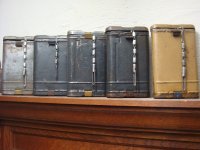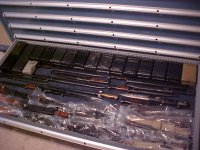
You are using an out of date browser. It may not display this or other websites correctly.
You should upgrade or use an alternative browser.
You should upgrade or use an alternative browser.
All the 5 kind of K98 cleaning kits RG 34
- Thread starter Bizar
- Start date
Bizar
Well-known member
How do you classify these as 5 types? I know there were changes throughout production (especially chains and oilers) but I thought they were all RG34. There are 2 types of cans as well but it has to do with the factories that made them?
Maybe it's a little bit confusing.
I categorise them in 3 major parts according to their year of fabrication ( and so with their different made contents)
I'm now explaining it just for the cans
- the prewar version is made of tinned steel.
In the prewar manufactured kits the metal case was made from "Weißblech" or tinplate. Tinplate is a thin sheet of cold rolled steel, whose surface is coated with tin, getting a relatively good corrosion resistence. From circa 1939 to the end of the war, the tinning was deleted and the case was paint finished. This was the most significant change in their manufacture. Another external change, circa 1940 onwards, was the use of steel latches instead of the brass ones.
- the early and mid-war types are painted. But here we have 3 different models of the cans
From 1940 two firms (Hawig and Mundlos) incorporated in their manufactured cases reinforcing lateral grooves for to fix the internal metal sheets to the case. The most significant change on these grooves was that from early 1942 onwards the horizontal long groove was stamped cutted in two lines forming a long "I" and a small "L".
- the late war cans which is the same as the common mid-war types
And if we take a closer look at the inside whe also can see the different methods of attaching the pin of the latch to the can.
The whole serie of RG34 is worth it to study.
Later on i"ll explain everything with text and photo's of my collection.
heavy_mech
RKI- Reasonably Knowledgable Individual
Nice grouping! Don't think I ever saw 5 types together before.
 Interesting. Thanks for sharing the details too!
Interesting. Thanks for sharing the details too!There is much good information here by a researcher who is also a member of this forum.
http://rg34.blogspot.be
- Not mentioned - There are at least two types of blued steel latches - Type 1 (transitional) and Type 2 (reinforced)
- G. Appel painted their latches (Type 2)
Mike - I have never seen or recorded an arr44 marked can. Would like have a photograph for the files. There are some very scarce cans marked arr > 4 in two lines or "stacked" as well as a few rare examples marked with only arr (no date). There are also some late war period cans unmarked but clearly constructed by by Braunschweigische Blechwarenfabrik that are also scarce. Perhaps the rarest of the Braunschweigische cans are the rco4 marked examples. Have recorded very small numbers made early in the transition from code arr to rco. From arr4 to rco4 which was for unknown reasons was quickly changed to rco44.
Agreed that these cleaning kits are an interesting area of research .....
http://rg34.blogspot.be
- Not mentioned - There are at least two types of blued steel latches - Type 1 (transitional) and Type 2 (reinforced)
- G. Appel painted their latches (Type 2)
Mike - I have never seen or recorded an arr44 marked can. Would like have a photograph for the files. There are some very scarce cans marked arr > 4 in two lines or "stacked" as well as a few rare examples marked with only arr (no date). There are also some late war period cans unmarked but clearly constructed by by Braunschweigische Blechwarenfabrik that are also scarce. Perhaps the rarest of the Braunschweigische cans are the rco4 marked examples. Have recorded very small numbers made early in the transition from code arr to rco. From arr4 to rco4 which was for unknown reasons was quickly changed to rco44.
Agreed that these cleaning kits are an interesting area of research .....
Although the basic RG34 remained pretty much the same throughout it's wartime production, we collectors have discovered a myriad of variation in the construction and manufacturer markings on the tins, spoons, chains and oil bottles (other than color of material used, brushes display the least variation). Once relatively common, original WW2 German issue kits are becoming less so today. Many of the kits found are of post-WW2 origin or export kits (typically ex-Portuguese). In addition, export kits are sometimes found with spurious WaA or other markings...obviously doctored up to increase sales to the uninformed. I currently have 32 wartime kits, plus four post-WW2 examples of German or Austrian origin:
Attachments





